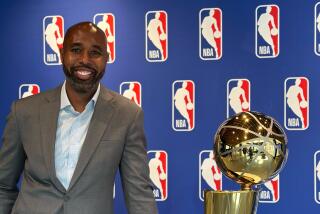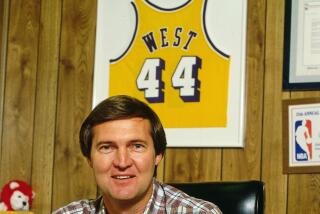East Is Not a Beast, but It Looks Meaner
- Share via
NEW YORK — The East is back!
Well, it just won a game in the NBA Finals, anyway, no doubt thrilling Commissioner David Stern, who has been telling us these four one-sided years of wandering his tilted landscape that these things are cyclical.
Not that there’s any question that he’s right. Let’s face it, Shaquille O’Neal, Kobe Bryant, Tim Duncan, Chris Webber, Dirk Nowitzki, Kevin Garnett, Yao Ming, Steve Francis, Stephon Marbury, Amare Stoudemire and Shawn Marion can’t play forever.
Nor is the East without prospects, as Stern reminded us for the umpteenth time last week.
“For myself, these things are ebbs and flows,” he said. “Let’s see how LeBron James and Darko Milicic add to the fabric of the East.”
Of course, the question remains whether the balance will be redressed within Stern’s tenure, or our children’s lifetimes.
James and Milicic each just turned 18, and if Stern had his way, neither would be eligible until the 2005 draft, which would still be way early to expect them to alter any landscapes.
Happily for the league, the New Jersey Nets beat the San Antonio Spurs in Game 2, tying the series, 1-1, and injecting a modicum of interest for the first time since the Philadelphia 76ers stunned the Lakers in the 2001 opener.
Unhappily for the league, that was the last Finals game the East won until Friday night.
Not that the league’s marquee event has been damaged or anything, but Game 1 drew a 6.4 rating, which Stern attributed to the earlier start he wanted, to keep faith with the youth of America, he said.
This was just another deft bit of thinking on his feet by the Great Litigator. The start may have shaved 5% to 10% off their number, but this was a plunge of nearly 40% below last spring’s overall 10.2, which was already the league’s worst in 21 years.
Of course, what else is new?
In this age in which “broadcasting” has been replaced by “narrowcasting,” no none is sure what to make of ratings, which always go down.
Take “Monday Night Football,” the thousand-pound gorilla of sports programming. It brought in comedian Dennis Miller to spice up the ratings, set records lows for two years, sprang for the respected John Madden ... and set another record low.
Commishes and network biggies aren’t eager to talk about this -- Our job is to try to hang on to as much as we can of what’s left -- so what you get, instead, is doubletalk about demographics and beating the old time slot, even if all they had in the old time slot was some steroid-bloated hulk towing a semitrailer with a rope held between his teeth.
(This is not a joke. Beating the old time slot explains more otherwise unanswerable questions, such as: Where did ESPN’s “Around the Horn” come from and why hasn’t it gone away?)
Stern, a sharp cookie when not up against insuperable challenges, such as waiting for the East to rise or finding a mass audience for the WNBA, dodged a cannonball when he took his TV package away from his pal, NBC’s Bob Ebersol, who offered a cut so huge, the salary cap would have dropped from $42 million to about $32 million.
Instead, he took it to ABC, at roughly the old level. Unlike NBC, which had no sports cable network, ABC could farm out dozens of games to ESPN, or ESPN2, which generate more revenue. Even with so-so ratings and production that left a lot to be desired, the rookies at ABC say they’ll make money on the deal Ebersol insisted would ruin him.
Stern’s No. 1 concern is not ratings but guaranteeing a profit for his owners, who pay his $8-million salary. Indeed, the NBA landscape has turned profitable in recent years as the salary cap finally began slowing the rise of costs.
So if it’s the first year of the deal, ABC is happy and the commercial spots are sold out -- as they are for these Finals -- Stern is a happy commissioner, indeed.
However, the new cable-centric package has cut down the league’s total audience -- those “eyeballs” you hear so much about in marketing -- by perhaps 33%. This poses a challenge to the traditional marketing axiom that equates exposure with growth.
Now, with a more targeted approach, Stern may well regain his1990s status as the commissioner who taught all the others how to market, if he can do one thing: Revive his Finals. He now gets one two-week period a season in which his league is exposed to a mass audience by an over-the-air network, making it all the more important that he put on a show, not a hype.
And, although this often seems to be lost, Stern isn’t selling LeBron, Kobe, Shaq, light shows, surround sound, the Rolling Stones, Christina Aguilera, Mariah Carey, Frank Sinatra, Elvis Presley and Lisa Marie Presley, as much as he’s selling competition.
Competition, of course, is what’s lost when one conference dominates.
Not that the West’s domination will last forever but at the moment, the East’s best and biggest young teams, the Indiana Pacers and Chicago Bulls, are still not ready. Meanwhile, the West has an awesome roster that would seem to suggest this league won’t return to a level playground soon.
I’ve been trying to help Stern with this problem for years, suggesting he redress his East-West imbalance by seeding the final four.
I don’t blame him for pooh-poohing it the first time I brought it up. It was during the 1999 Finals and even if the Spurs led the New York Knicks, 3-1, the East had won eight of the last 10 titles.
Of course, if you looked around, you might have noticed that almost all the good big men were suddenly out West, suggesting the pendulum was about to swing that way with a vengeance, as it did.
Stern has since pooh-poohed my suggestion at every Finals until this one, because I was tired of hearing these things are cyclical and no one ever said this in the ‘90s, when the Bulls were winning. So I stopped asking him about it.
(In case you were in a coma in the ‘90s, the reason no one said that was because the Finals were still competitive, even if the Bulls won six of them. Five of them went six games. Only one has gone six since, after the Lakers led the Pacers, 3-1, in 2000.)
Nevertheless, a growing number of people now advocate seeding. It used to be just me. Now it’s me and Peter May of the Boston Globe.
The seeding question did come up this spring (it’s happening!) so Stern got to pooh-pooh that guy -- Filip Bondy of the New York Daily News -- instead of me.
“We’ll see how the Nets do,” noted deputy commissioner Russ Granik, Stern’s tag-team partner, after Stern did his usual I-don’t-understand spiel.
“To me, it doesn’t matter at all,” Stern said, “but I’m respectful of those who have raised the issues and I think we’ll consider it with all other issues.”
In other words, he won’t do anything and wishes we’d stop bothering him with our gimmicks, although, in light of recent debacles, he really doesn’t have an answer.
The real problem is, this isn’t a coincidence anymore.
There’s now an East culture, with many team officials noting they don’t compete against anyone that big and don’t have to worry about adding size. So West general managers are out signing up every available big man to throw against Shaq and East teams are content to start their little Ben Wallaces and Tony Batties at center.
One of them finally must face the West in the Finals, where it annually makes the mistake of trying to play O’Neal or Duncan straight up, because that’s how they played everyone in the East all year.
The 76ers’ Larry Brown tried it in 2001 with Dikembe Mutombo, who made the further mistake of announcing he wasn’t intimidated by O’Neal, whereupon Shaq laid him out about half a dozen times, while putting up the usual numbers.
Last spring, the Nets’ Byron Scott tried to guard O’Neal with Todd MacCulloch. By the time Scott figured out that was a nonstarter, the series was over.
This series has only begun and already the Nets have started helping whoever’s guarding Duncan and won a game!
Hope springs eternal in the league office. Maybe James can make the difference. All he has to do is be as great as everyone thinks he might, and grow six inches.
It’s a lot to ask a 6-foot-6 high school senior, but now he has a whole conference depending on him.
More to Read
All things Lakers, all the time.
Get all the Lakers news you need in Dan Woike's weekly newsletter.
You may occasionally receive promotional content from the Los Angeles Times.






